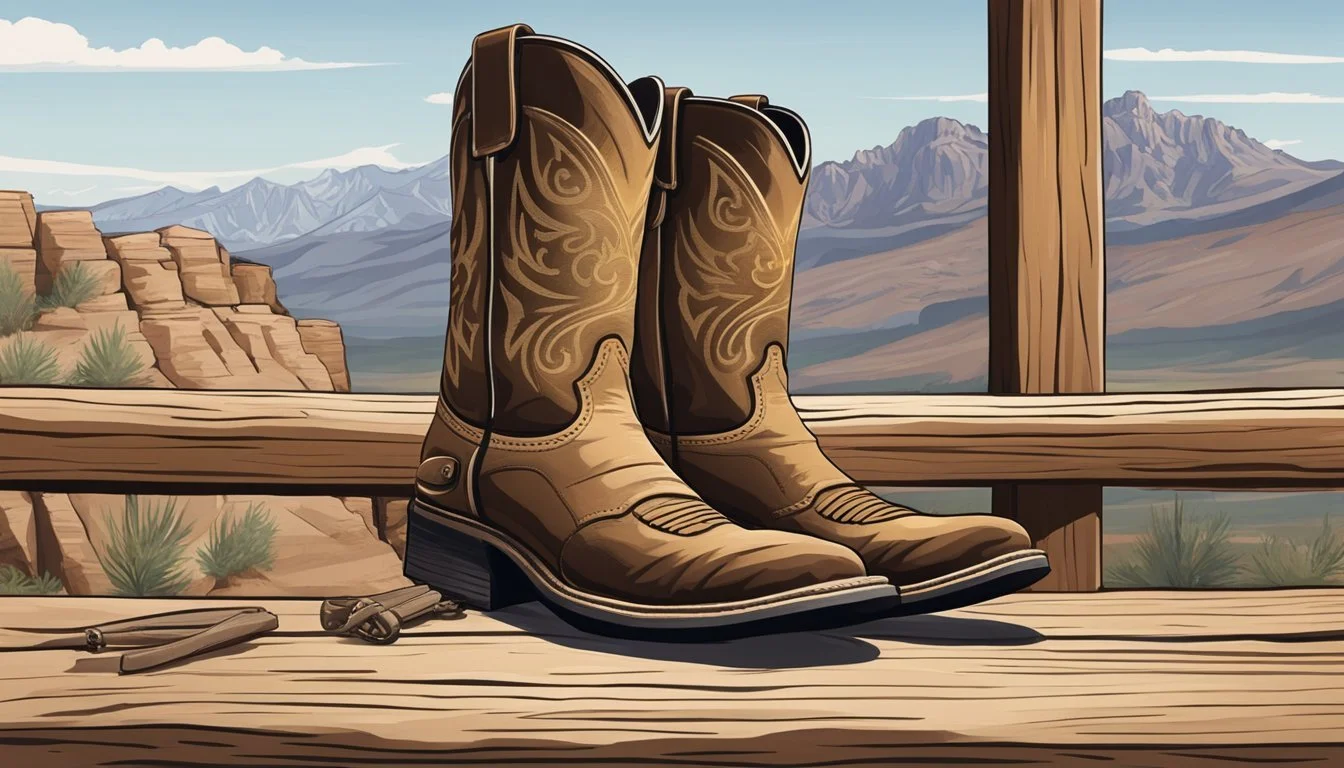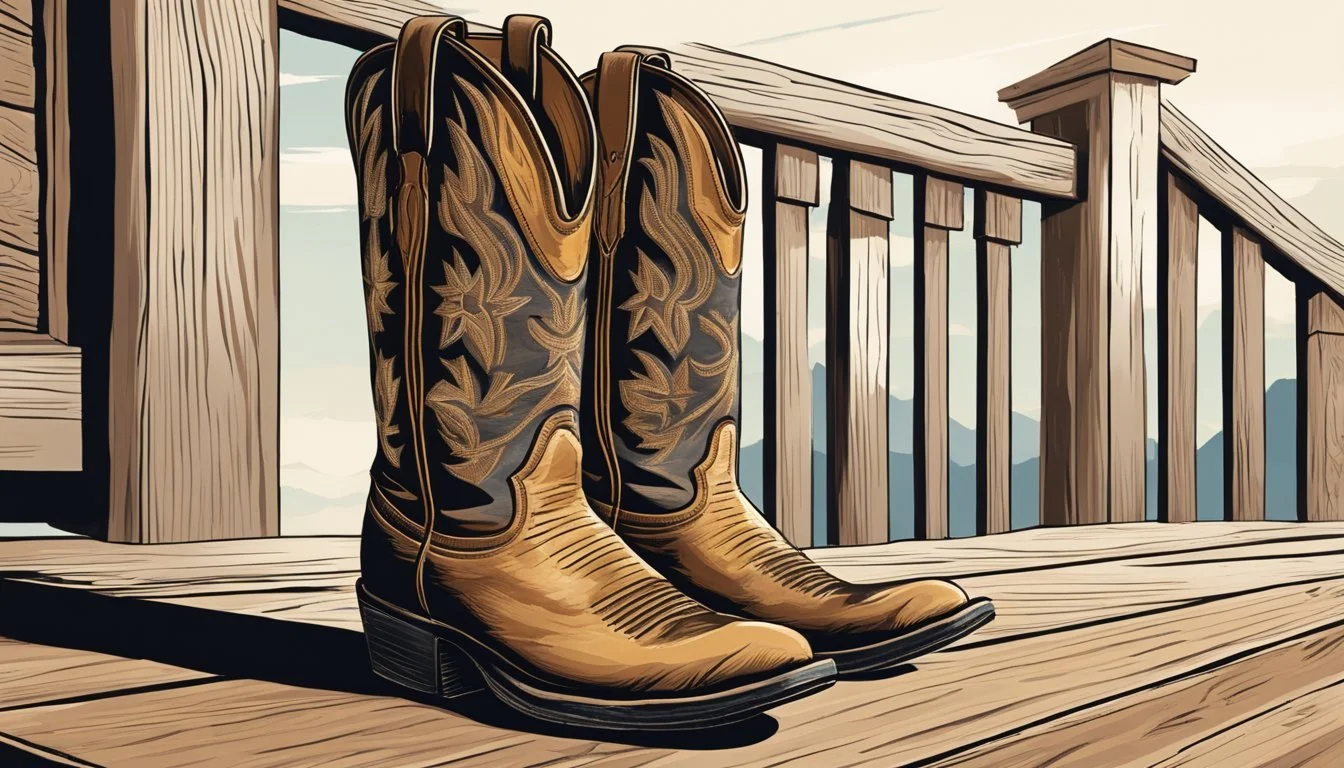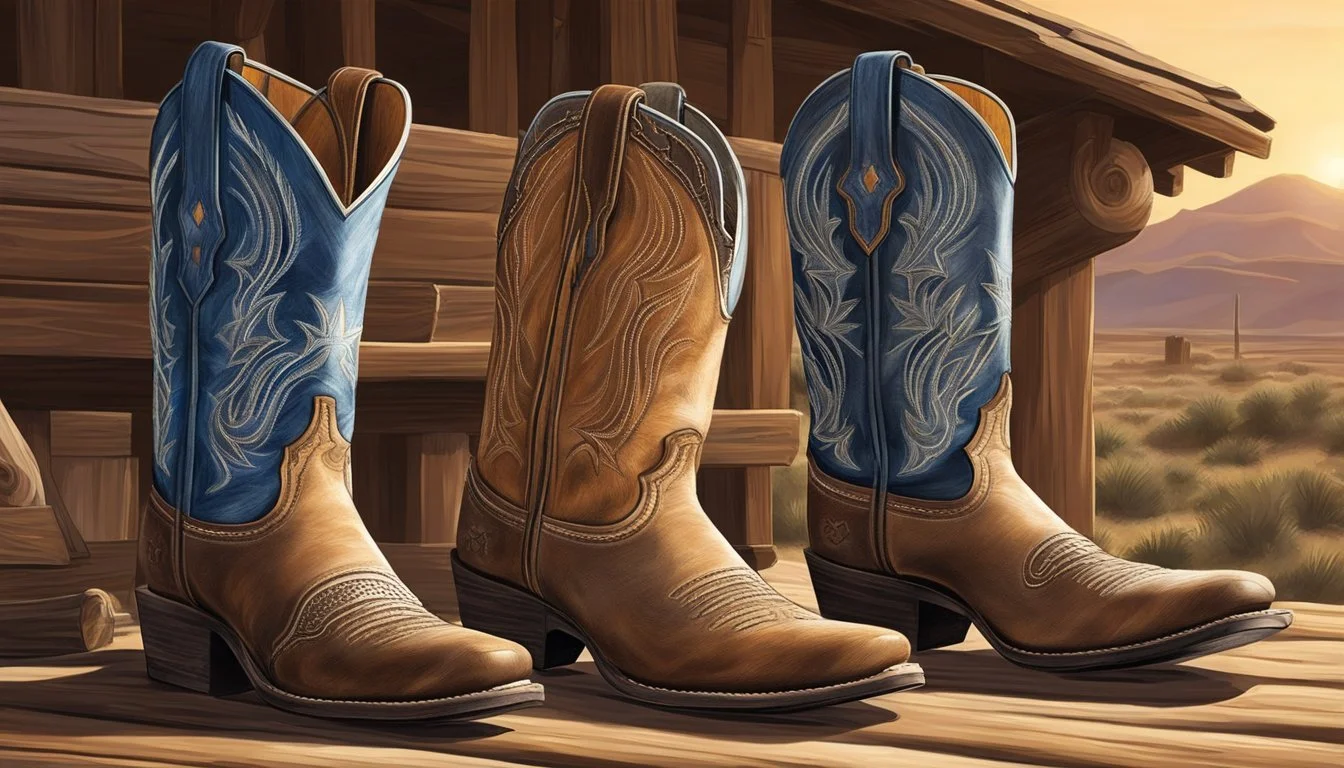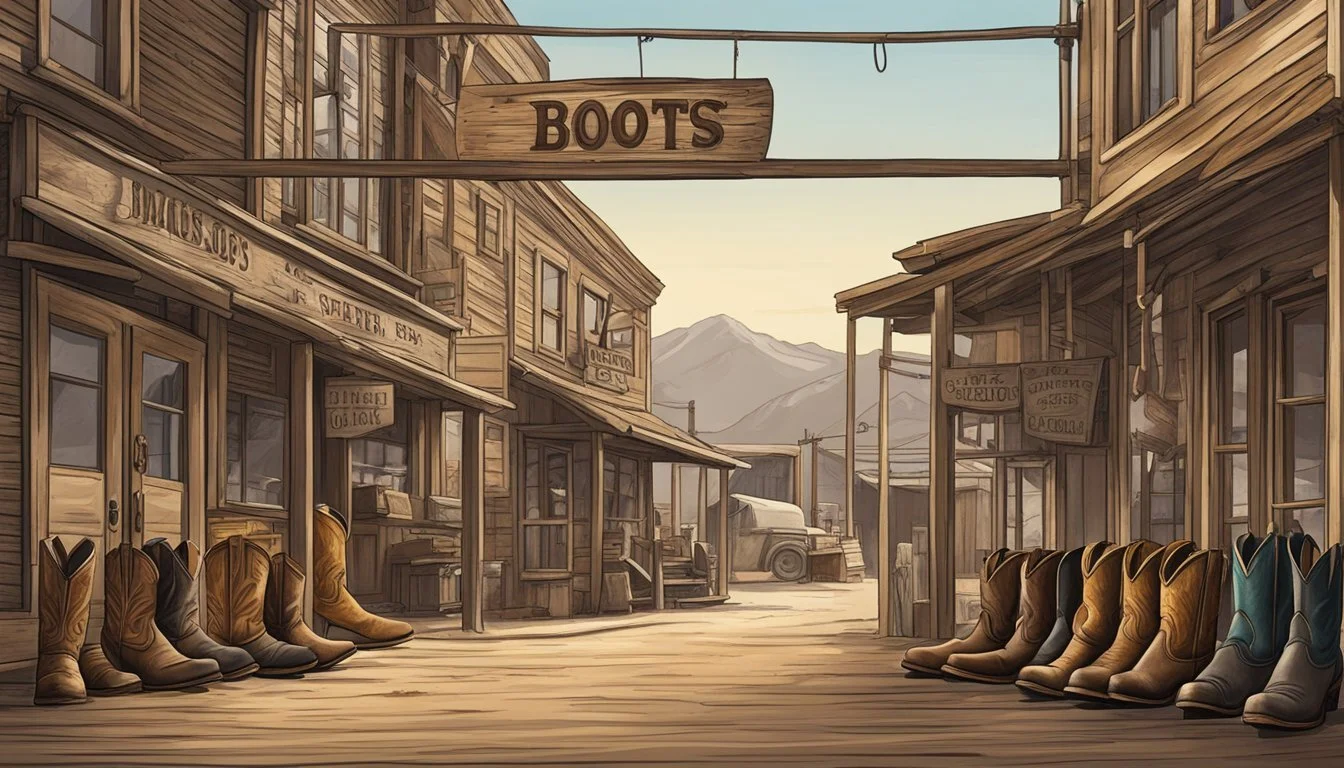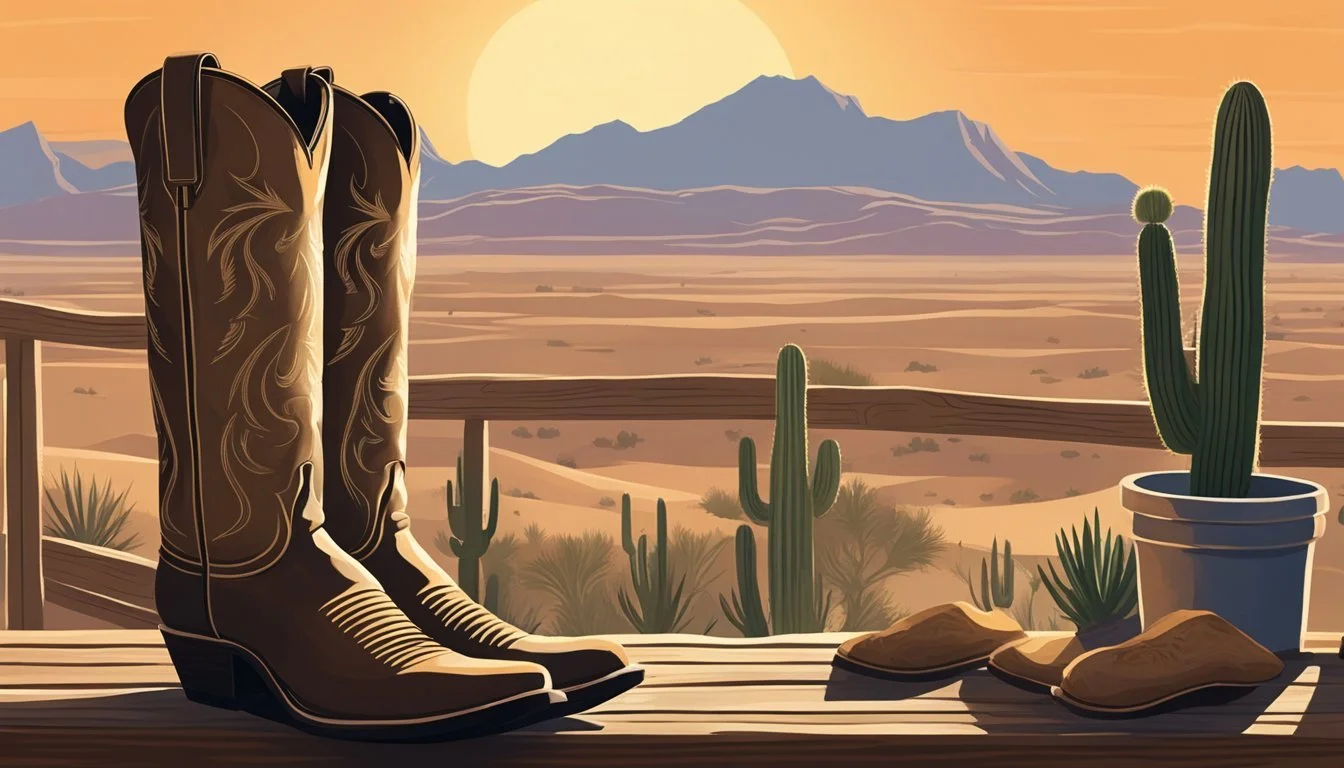The Importance of Cowboy Boots in Western Culture
A Symbol of Heritage and Resilience
Cowboy boots, a distinctive footwear with a storied past, have become an enduring icon of American West culture. Originating as functional gear for the rugged demands of frontier life, they have transcended their utilitarian roots to become a symbol deeply embedded in American identity. With their high tops, which protect the shins, pointed toes designed to slip into stirrups, and sturdy heels to hold feet in place while riding, cowboy boots were meticulously crafted to meet the needs of cowboys herding cattle across the vast American plains.
Over time, the practical aspects of cowboy boots melded with stylistic embellishments, giving rise to a fashion statement within and beyond western culture. As the cowboy emerged as a cultural hero, the boots they wore became part of the American legend, popularized by Western films and country music. They serve not just as an article of clothing but as artifacts of a storied era, symbolizing values such as rugged individualism, freedom, and a connection to the land.
Today, cowboy boots maintain their place in fashion and function within modern American culture, extending their reach well beyond the American West. They are worn by presidents, celebrities, and everyday people who admire the spirit and history they represent. Though styles and designs have evolved, the essence of the cowboy boot remains the same – a testament to the enduring legacy of the American cowboy and the spirit of resilience, adaptability, and adventure they continue to inspire.
Historical Significance
Cowboy boots hold a pivotal place in American Western culture, stemming from their functional origins to becoming a symbol associated with the ethos of the rugged West. Their evolution echoes the history and changing needs of cowboys and ranchers throughout American history.
Origins of Cowboy Boots
The creation of cowboy boots is attributed to the necessity for sturdy footwear that could handle the harsh conditions encountered by cattle herders. As cowtowns sprang up, the first known cowboy boot shop was established in Abilene, Kansas, providing high-quality boots that facilitated the rigorous work of early ranchers.
Evolution from War to Ranch Work
Originally, cowboy boots were influenced by the boots worn by cavalry soldiers of the Civil War, whose footwear was designed for long hours on horseback and rough terrain. Post-Civil War, bootmakers adapted the design to suit the needs of cattle ranchers involved in long cattle drives from Texas northward, leading to the distinctive tall tops and underslung heels.
Influence of Vaqueros and the American Frontier
The design of cowboy boots was heavily influenced by the traditions of the vaquero, skilled horsemen from Mexico. Early American cowboys adopted much from the vaqueros, including the design of their boots, which were made to be functional for riding and working on ranches across the burgeoning American frontier.
Cowboy Boots and American History
Throughout history, cowboy boots became more than just footwear for ranch work; they became a testament to the identity of the American West. Texan craftsmen quickly became known for their quality boots, and by the end of the 19th century, cowboy boots were an integral symbol of American cowboy heritage.
Design and Craftsmanship
The design and craftsmanship of cowboy boots showcase a rich legacy of elegance and function. These boots are much more than mere footwear; they represent a profound dedication to quality and tradition in Western culture.
Materials and Construction
The materials and construction of cowboy boots are pivotal for both their durability and comfort. Leather is the principal material, cherished for its resilience and ability to conform to the wearer's foot. Bootmakers often choose from cowhide, snake, alligator, and ostrich (What wine goes well with ostrich?) leathers for different textures and levels of flexibility. Construction techniques, essential for boots to withstand the rigors of wear in stirrups, have remained relatively consistent over time, reflecting a commitment to proven methods in boot craft.
Artistry in Boot Making
Artistry in boot making manifests through unique decorative stitching and tooling that highlights the bootmaker's skill. Design patterns range from the simple to the intricate, with each stitch contributing to the boot's aesthetic and structural integrity. Skilled artisans may incorporate other materials or dying techniques to produce visually striking themes, making every pair a testament to the artist’s craft.
Distinctive Features of Cowboy Boots
Cowboy boots are identifiable by their distinctive features designed for practicality and style:
Heels: Typically angled, the heels prevent slipping through stirrups.
Toes: Often pointed, the toes make it easier for the cowboy to slip in and out of stirrups.
High Tops: Serve to protect the legs from scratches and bites.
These elements serve as hallmarks of the cowboy boot, combining functionality for the wearer with a timeless aesthetic appeal.
Cultural Impact
The cowboy boot has transcended its utilitarian roots to become a powerful cultural symbol, reflecting the ethos of the American West and exerting influence in various facets of society, from entertainment to fashion.
Rodeos and Western Competitions
In the context of rodeos and western competitions, cowboy boots are an essential part of the competitors' attire. They are not just for show; the boots' high heels aid in keeping the rider's feet in the stirrups, while their tough leather construction offers much-needed protection. Rodeo participants often see their boots as both tools and trophies—a testament to their skills and achievements.
Western Films and Hollywood's Role
Hollywood cinema has played an instrumental role in cementing the image of cowboy boots within American culture. Western films, often characterized by their vivid portrayal of the rugged terrain and the hardy individuals who survived it, frequently feature cowboy boots. Stars like John Wayne wore them, and they became as iconic as the films themselves, linking boots to bravery and the pioneering spirit.
Cowboy Boots in Music and Dance
Country music and line dancing scenes recurrently showcase cowboy boots. They represent more than fashion; they echo the roots of country music that celebrate stories of everyday life and the values of the heartland. Cowboy boots are common both on stage, worn by performers like Johnny Cash, and on the dance floor, where they click and stomp to rhythms of the genre's most legendary tunes.
Symbolism and Identity
Cowboy boots symbolize an array of values including freedom, self-reliance, and the American pioneering spirit. They have become a fashion statement that serves as a nod to cowboy culture. For many, wearing cowboy boots is a deliberate choice that signifies a connection to a storied way of life or an aspect of their personal identity.
Fashion and Style
Cowboy boots have transcended their utilitarian roots to become a significant element in both mainstream fashion and haute couture. Their distinctive silhouette and historical influences leave an indelible mark on modern wardrobes and fashion movements.
Mainstream and High Fashion
Cowboy boots made a transition from rugged workwear to fashion statements as they began to appear on runways and in fashion magazines. High fashion brands have incorporated the iconic boot, showcasing how a classic Western item can be reimagined in luxurious materials and bold designs. The stylized versions of these boots often feature intricate details, exotic leathers, and recognizable patterns.
Incorporation in Runways: Adapted by designer labels with luxe materials.
Design Evolution: Embellishments and unconventional colors.
Function Meets Fashion
Originally crafted for cowboys in challenging terrains, cowboy boots combined practicality with style. They offered protection and durability, yet their unique stitching and shape quickly elevated them to a fashion item. Even in contemporary work settings or casual environments, the element of fashion in cowboy boots remains apparent.
Protection: High durability for various terrains.
Aesthetic Appeal: Stitching and shape contribute to visual interest.
Influence on Modern Wardrobe
Cowboy boots have influenced the modern wardrobe by becoming a timeless accessory adaptable to various styles. In popular culture, they are worn by Hollywood actors, musicians, and public figures, and serve as a statement piece reflecting an individualist spirit. Their influence is evident in the variety of footwear options available today.
Hollywood and Musicians: Boots as signature pieces for public figures.
Wardrobe Staple: A statement piece for individualistic expression.
Variety and Personalization
Cowboy boots have evolved through the years to embrace a range of styles and materials, providing wearers with numerous options for personalization. The intersection of tradition, style, and individual expression find a unique platform in cowboy boots.
From Classic to Modern Styles
Originally designed for practicality with high tops and a sturdy heel, classic cowboy boots featured a pointed toe that made it easier to slide into a stirrup. Today's styles balance the functional needs of cowpersons with the fashion preferences of a broader audience. Modern variants include the traditional pointed toe as well as rounded and square toes, catering to diverse aesthetic tastes and comfort considerations.
Exotic Leathers and Collectors
Cowboy boots crafted from exotic leathers such as alligator, snake, ostrich, and lizard have emerged as collectible items for enthusiasts. These materials not only add a luxurious touch but also signify both status and the personal connection to the Western lifestyle. Collectors often seek limited-edition releases or rare vintage finds that display unique patterns and craftsmanship.
Exotic Leather Desirable Qualities Alligator Durability and distinct scale pattern Snake Unique texture and color variations Ostrich Softness and quill patterns Lizard Fine grain and glossy finish
The Custom Boot Experience
For the individual seeking a truly personalized fit and design, custom-made boots offer a bespoke experience. Customers can specify each element of the boot, from the toe shape and heel height to intricate designs and monograms. These custom boots become an extension of the wearer's identity, meticulously handcrafted to meet precise specifications.
Pointed Toe: For a classic silhouette
Exotic Leathers: Tailoring luxury to personal taste
Custom-Made Boot: The epitome of individual expression
Each pair of cowboy boots tells a story — a narrative woven from the owner's preferences, the artisan's skill, and the rich legacy of Western culture they uphold.
Industry and Brands
The cowboy boot industry has a storied history with several brands emerging as pillars of American craftsmanship, influencing both consumer demand and fashion trends across various markets.
Famous Bootmakers and Brands
Tony Lama: Established in 1911, Tony Lama rose to prominence in the 1940s and has maintained a reputation as one of the United States' traditional Western boot manufacturers.
Lucchese: Known for high-quality boots since 1883, Lucchese has been a key player, producing luxury cowboy boots that embody both tradition and fashion.
Hyer Brothers Boot Company: The Hyer brothers started their bootmaking legacy in the late 19th century and are celebrated for creating some of the earliest bespoke cowboy boots.
Justin Boots: A brand that began in 1879, Justin Boots has developed into a household name, known for durability and style within the cowboy boot industry.
Market Evolution and Consumer Demand
The cowboy boot market has undergone significant evolution. Initially crafted for cowboys, these boots have transitioned into the fashion world, expanding their influence beyond functional workwear.
Industry Growth: As American culture embraced Western wear, cowboy boots saw an increased demand, leading to the expansion of bootmaking brands and diversification of styles.
Consumer Trends: Modern consumers seek a blend of tradition and contemporary design, pushing brands to innovate while retaining classic elements that define cowboy boots.
Maintenance and Longevity
Maintaining cowboy boots is as much about preserving their function as it is about honoring their place in Western culture. Proper care ensures these boots can withstand the test of time and continue to symbolize the resilience of the Western spirit.
Care and Condition of Cowboy Boots
Materials: Cowboy boots come in various materials, each requiring specific care. Leather boots, particularly, need regular cleaning and conditioning to prevent cracking and to maintain their shape.
Cleaning: Remove dirt with a soft brush or cloth.
Conditioning: Use a conditioner suited for the type of leather.
Polishing: For added protection and shine, apply a quality polish.
Moisture Avoidance: Always store in a cool, dry place.
Note: Never expose boots to prolonged dampness or direct heat.
Durability and Legacy
Construction: A well-crafted cowboy boot can be exceptionally durable due to its sturdy construction. Regular maintenance not only enhances durability but also the legacy, allowing boots to be passed down through generations.
Inspection: Perform frequent checks for wear and tear.
Storage: Keep boots in shape with boot trees or supports.
Repair: Address issues like worn soles or heels promptly.
Fact: A pair of well-kept cowboy boots can last decades, embodying the enduring quality associated with Western gear.
Cowboy Boots in the Global Context
Cowboy boots, while rooted in the tradition of the American West, have extended their influence to various cultures worldwide and have been adapted in unique ways that reflect the diversity of global fashion trends.
Influence Beyond the American West
Cowboy boots have transcended their regional beginnings to become a symbol of Americana globally. They embody a spirit of rugged individualism and have been associated with the image of the cowboy, an icon that resonates beyond the United States. In Europe, the allure of cowboy boots can be seen in fashion runways, where they are sometimes incorporated into high-fashion ensembles, suggesting a blend of the rustic West with contemporary style.
Adaptations Across Different Cultures
In different cultures, cowboy boots have been reimagined to fit local tastes while still retaining their original ethos. Native American artists have for instance contributed to the richness of cowboy boot design by incorporating traditional motifs and beadwork that tell the story of their heritage. Similarly, in Mexico, especially the region of Matehuala, cowboy boots have been transformed with elongated, pointed toes to complement the local dance culture. Such adaptations not only celebrate the traditional aspects of cowboy boots but also highlight their versatility and enduring appeal in the cultural tapestry of fashion.
Social and Economic Aspects
The economic fabric of cowboy boots intertwines skilled craftsmanship with significant economic contributions, from the wages earned by artisans to the boots' status as valued collectibles.
Manufacture and Workmanship Wages
In the manufacture of cowboy boots, craftsmanship plays a pivotal role. Each pair is often handcrafted with precision, demanding a high level of skill and labor from cobblers. Wages for these artisans can vary, reflecting their expertise and the materials used. For example, a bootmaker specializing in custom designs with exotic leathers may command a higher wage compared to those working on standard models. The geographic location of these artisans also influences wage levels, with bootmakers in traditional western regions possibly earning more due to the historical and cultural association of the area with cowboy boots.
Cowboy Boots as Collectibles and Auction Items
Cowboy boots have transcended their practical use to become prized collectibles, fetching high prices at auctions. The value of these boots at auction can be attributed to their unique designs, historical significance, or association with notable individuals. Collectors are often willing to pay a premium for boots that showcase exceptional artistry or that have been worn by celebrities in the Western world. A pair of well-maintained vintage boots might attract significant bids, highlighting the cultural value placed on these iconic symbols of the American West.

